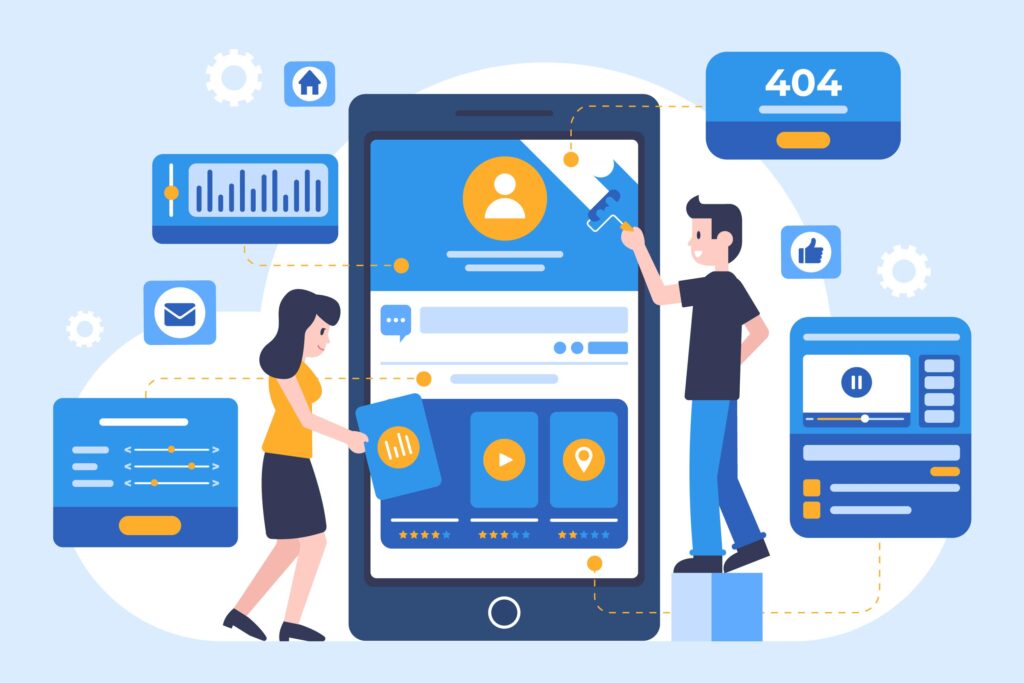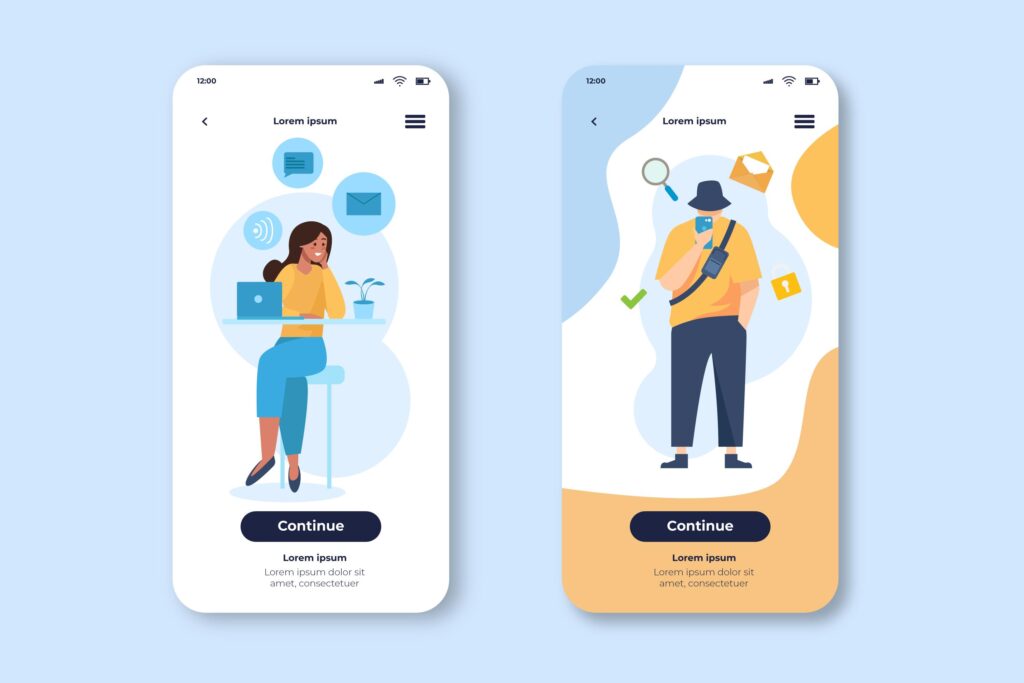
How to Build An AI App: A Step-by-Step Guide (2024)
AI has changed the world by using robots for precise tasks and having cars that drive themselves. And it’s just getting started. Businesses have begun using AI a lot more, like, 270% more in the last four years! It’s not just for solving math problems anymore; it’s becoming a big deal that’s going to shape our future society and economy.
Big companies, even the huge ones, are using AI to make their work easier. And because more and more companies are using it, the AI market is growing super fast. It was worth $51.08 million in 2020, but by 2028, it’s predicted to be worth a massive $641.3 billion!
Businesses aren’t just using AI to help themselves work better; they’re also using it to give customers personalized experiences. So, if companies want to stay in the game today, they pretty much have to get on board with AI. But how do you make an AI app?
This article gives you how to build an AI app and a step-by-step guide on how to do just that. But before we dive in, let’s make sure we understand the basics of AI.
What is Artificial Intelligence?
Artificial intelligence, called AI by experts, is computer science a part that enables computers to imitate humans. It helps them to detect patterns, and tackle problems to find solutions in the data. AI is a kind of technologic that is near the future, as it makes use of robots to build up a dream-like image of the future.
You may find lots of different explanations of AI, but after John McCarthy in 2004, it is about making machines intelligent in particular, programmable computers. This is similar to the point of showing computers to understand human intelligence, but AI is not limited to the range of which humans can think naturally.
AI is generally about applying computing and big data to achieve different tasks. Machine learning and deep learning, for example, are methods for computers to understand data and start to make predictions. AI is interdisciplinary; one must understand computer science, statistics, psychology, and philosophy.
What is an AI App?
An AI app, which is a type of software, is an application that can do tasks that humans ordinarily do by having intelligence. These apps employ algorithms and data to emulate the human mind’s thinking and decision-making processes. Such as, it has the ability to interpret spoken language, recognize objects in the images or it can suggest personalized content according to your preferences.

Machines achieve that by learning from patterns and data, and through doing so they improve in time at all the tasks they are programmed to perform. AI apps are becoming a part of our lives more and more and are used in various areas – from voice assistants like Siri and Alexa to recommendation systems which are part of streaming services like Netflix.
How does AI Work?
As we have mentioned before, just like the big umbrella that comprises machine learning and deep learning, AI is a primary component of them. AI or artificial intelligence feeds on big volumes of data and unravels rules from them. It mimics this pattern, and then uses it for forecasting or to solve problems. AI model construction is a very complicated process, which can be compared to exercising to achieve a health goal. The model and the human, the AI and the exerciser – they both train, learn, and progress together in order to get better. Because AI is a superpower, it can process huge data at high speed, and it can resolve problems without a human entirely.
AI can be split into different types:
- Artificial Narrow Intelligence (ANI): This is the most used steel variant since it is the most suitable for daily things. In simple terms, it is all about enabling the computers to deal with the particular challenges autonomously.
- Artificial General Intelligence (AGI): This is about programming computers as they do not think like humans.
- Artificial Super Intelligence: This is a second definition for the word AI which is more complex and abstract.
Now, there are some specific ways AI works with data patterns:
- Machine learning: This attribute causes the computer to learn from data, finding hidden patterns in the process.
- Neural networks: The human brain contains about 100 billion neurons that form web-like structures that resemble the processors in a computer. They, in their turn, boost computers’ abilities to process and react to data.
- Deep learning: This involves very powerful neural networks capable of learning complicated patterns from lots of examples. This is more useful in things like recognizing pictures or speech.
- Computer vision: This enables the computer to comprehend what is inside the pictures or video.
- Natural language processing (NLP): This is where computers begin to find themselves in a position where they have started to understand and even talk or write in a manner like us humans.
AI needs some special tools to work well:
- Graphical processing units (GPUs): They give us massive capability in terms of computing power because we need this for AI.
- Internet of Things (IoT): It gives more information from devices that are connected to it.
- Advanced algorithms: This class of algorithms learns from data to analyze it quickly and make predictions accurately.
- APIs: Such as toolkits that are fitted to install AI abilities in other software like image recognition or question-answering features.
Essential Building Blocks of AI
Artificial intelligence includes lots of different methods. Now, let’s explore the main areas within AI.
1. Machine Learning
Machine learning is a good thing it concerns modern technology. A company that develops a new product that is powered by ML, i.e., by smart algorithms and techniques, is able to surprise everyone with its amazing features. Machine learning is one of the crucial features that enable computers to learn things without someone programming them explicitly. It’s just like giving them the lessons to solve the issue by themselves and using real-life demonstrations.
To put it simply, machine learning is a way for computers to comprehend and use data in order to address the challenges that exist. Coders will use this advanced math and create the algorithms that are used like the descriptive instructions for the computer. Data is the driving force behind these algorithms, which allows computers to learn and make decisions or predictions.
Machine learning has achieved such feats as self-driving cars, image and speech recognition, demand prediction, and search on the net. It’s about making such applications that will be able to improve and become better at what they do with time and experience.
There are different types of machine learning, depending on what kind of data you have:
- Supervised learning: Here the experts train the computer to identify objects and label them properly. From the data thus gained, the computer establishes relations among the data and makes subsequent predictions.
- Unsupervised learning: In this learning method, the computer learns from data without the help of labels. It recognizes and calculates by itself. As an instance, let’s imagine it would cluster things together without being instructed about these items.
- Reinforcement learning: This is just like showing a machine a series of steps to be followed. The programmers will tell the computer what task to perform and what results to expect for both correct and incorrect task performance. The computer at this stage becomes able to make decisions based on these rewards and the consequences of these decisions. Sometimes it takes this insight even further and does its thinking.
2. Robotics
Doing this thing is a new area of artificial intelligence that has become very interesting and has two amazing aspects: designing and making robots. Robotics combines a number of disciplines such as mechanical, electrical engineering, and computer science. It’s like that: making, developing, and applying robots to make smart things, and that is all with the help of computers.
Robots are a common tool for those jobs that people can not do or that are challenging for them to finish. For example, they’re used quite often in car factories to assemble things more rapidly and more precisely. Additionally, they are used by NASA to move very large objects in space. While AI experts used to create robots that could do only a limited number of tasks, today they are working on building robots that can learn from experience and sometimes even communicate with people.
3. Natural language Processing
In simple words, NLP is a part of computer science and AI that helps humans talk to computers using normal language. It lets computers understand and read text as if they were humans. NLP helps computers search, analyze, and make sense of written words. Programmers use special tools to teach computers how to understand text information. NLP is often used to spot spam. For example, computer programs can check emails to see if they’re junk or not by looking at the content or subject.
4. Neural Network
A neural network is like a combination of brain science and machine functions that work together to accomplish a goal. It is a part of artificial intelligence that is based on neural nets, a branch of biology connected with nerves and the nervous system. Consider a neural network as a duplicate of the brain in the way it is composed of billions of neurons.
Artificial intelligence applications in business
AI is a new tech that’s just starting to grow, and it’s hard to imagine all the good stuff it can do. It is stirring up the market and crafting fresh opportunities for digital business. AI can be deployed in diverse industries and jobs. Here are some ways businesses are using AI:
Machine learning: This is a way of developing more human-like computers, as they will talk and act similarly to people. It is responsible AI, which is behind the scenes in areas such as chatbots, robots, and autonomous driving.
Deep learning: This involves the fanciness of technology that can recognize faces, voices, and patterns. It’s great for example, regarding personalized ads or security.
AI in IT: Virtual support agents provide the answers to IT troubles like fixing the computer or answering questions.
AI in supply chains: It assists in diagnosing and eventually fixing faults, determining what is necessary for the operation, and buying products needed for business.
AI for sales: AI is capable of finding new customers and also assists in promoting more items by suggesting to them what they might prefer.
AI in marketing: It refers directly to customers and assists businesses in determining the desires of customers.
How to build an AI App?
The information presented in this guide will help you to make and use your own AI app. If you are a researcher, business person, or simply interested in AI, these steps will guide you toward the development of a system that can completely redefine the way things are done within your field.

1: Know the Problem
Before jumping straight into the development of an AI app, the first thing to do is determine the issue that you want to tackle. Let your imagination run wild and come up with AI-powered app functionality that you want to achieve. What do you see it as an outcome, and what kind of goodwill does it bring to you? When you have a certain problem in mind and you know exactly what you want to achieve, you start to figure out what the app should have.
During this planning stage, you should:
1. Think about who your team will consist of, technical (for example programmers) and non-technical (such as project managers).
2. Discuss with your team the timetables and deadlines, when things have to get done.
3. Begin to hunt for the data that is necessary for training your AI model.
2: Prepare the Data
AI-based apps mainly use data to work but before such data is used, it should be collected properly and organized in a manner that makes the app function well. A team of specialists in AI and ML can help categorize the data appropriately. In these processes, domain experts carefully examine the data and sources to get them ready for use; following a standardized process called CRISP-DM.
Then, the input data is scrutinized for typos or holes, after which it is cleaned up. This involves:
- Loading the data and choosing the Raw data.
- Picking the tools needed to highlight the data.
- Tagging and emphasis on the data.
We are going to focus on finding the processed data and saving it in a file.
The next step would be to feed the data into the system in order to have comparable solutions. The model training can be performed further. The ML model training is done on the data acquired before which is done with different procedures.
3: Choose Algorithm
Now, let’s talk about the most important part of making an AI system: getting the right algorithm. Whereas it may well be hard, it is of utmost importance to understand some fundamental ideas behind the choice of an algorithm for the task. There are various types of algorithms used which differ in the way they learn.
An algorithm choice is critically important for a fine-tuned AI system. By understanding of supervised and unsupervised learning and knowledge of the different algorithms, you can ensure that your AI system is precise and right.
4: Train algorithms
After you have decided on the algorithms, training is another thing to do to see whether it works. Nevertheless, the algorithm cannot be tested for accuracy all the time, therefore, it is essential to keep training and developing it until it gives the right results.
While AI uses data as its main working tool, having a better quality of data helps the algorithm work better. The training of the algorithm is costly in terms of time and resources; however, this is a worthwhile endeavor. It improves workflow, reduces expenses, and makes you stand out from the competition.
5: Choosing the language for AI
The roadmap is the most important thing in an AI solution-making process that is already predetermined. Besides the proper technology and programming language, they must be both in place for the most efficient smart AI system to be created to fulfill their customers’ needs.

Programming languages are very diverse, and some of them are more efficient for a specific task than others. The specific tool that you choose is going to be based on what you are planning to do, so make sure the device you pick is suitable for your project.
Some languages have innate features that are good at handling a lot of information, while other languages have better features for working with natural language. While making the language selection, you should look at what are the strong points of each one of them and where they might be weak. Here are some popular languages to consider for your AI app:
- Python
- Java
- C++
- R
- Prolog
- Lisp
- Haskell
- Smalltalk
- Rust
6: Selection of Platform
An AI application usually consists of multiple frameworks and APIs that provide us with smart algorithms to fulfill our tasks rapidly. Such functions as deep learning, neural networks, and NLP tasks are already included among the existing tool’s built-in features.
When choosing which APIs and platforms to use for your AI project, consider these key factors:
- Choose the cloud platform you prefer, like a hybrid cloud setup.
- Think about where your data will be stored and who owns it.
- Consider any limitations of the programming language you’re using.
- Check if the APIs you need are available in your region.
- Factor in the cost of developing and maintaining your AI app.
7: Final development
Unlike the usual building up of software development, making an AI-powered application requires some stages, followed by CRISP-DM. Here are the main parts of AI development: Here are the main parts of AI development:
- Defining the mechanism of the answer.
- Providing details of how users will interact with the app.
- Developing both the frontend, which users can see and the backend, which refers to the systems that run the app.
Meanwhile, as you continue working on your software, you can also make it quicker, add more features, and prepare it for updates in the future.
8: Testing and Monitoring
After finishing the development, it’s time to test the app with QA engineers. They can use automated tools, do tests by hand, or use a mix of both. The app can only be released if it’s been checked thoroughly and works like it should. Once testing is done, the app is put on the main server for people to use.
After that, a support team keeps an eye on the app to fix any issues and keep it running smoothly. Maintaining an AI app is special because it needs constant updates with new data and ideas to stay accurate. This includes regular updates for security and new versions.
Conclusion
AI is able to learn in-depth, thus, it can match with humans in performing complex tasks, hence is very crucial for business growth and development. It has been witnessed that a lot of industries are adopting AI with the mantra of making customers happy. This helps the businesses to not only make the customers happy but also to stay ahead of the competition.
AI has a lot of promising prospects in such fields as finance, social media, and healthcare which can open up many new opportunities for the advent of new ideas and development. However building AI apps is difficult and cannot be done by anyone without some knowledge of AI, machine learning, and data science. Therefore, a good AI development company with a proven track record of success should be hired in order to increase the likelihood of your project being successful.
Frequent Asked Questions (FAQ’s)
How can I make my own AI App?
You can create your own AI App by abiding by these guidelines:
- Know the Problem
- Prepare the Data
- Choose an Algorithm
- Train the algorithms
- Choosing the Language for AI
- Selection of Platform
- Final development
- Testing and Monitoring
How much does it cost to start an AI App?
It is possible to create an AI app for $10,000, while complex effects can cost around $200,000 or more. Estimate a DIY approach or go for the more affordable pre-existing tools and projects base to save for your budget.
Are AI apps hard to make?
AI apps may have multiple parts to the code, but using pre-made development components solves this issue. You may not have to be someone really familiar with the coding languages, nowadays.



